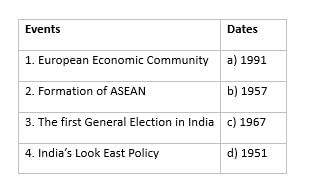Test: Contemporary Centres of Power- 1 - UPSC MCQ
10 Questions MCQ Test Indian Polity for UPSC CSE - Test: Contemporary Centres of Power- 1
Assertion (A): The establishment of the European Union in 1992 was a direct result of the disintegration of the USSR.
Reason (R): The Cold War fostered economic and political cooperation among European nations after World War II.
Which of the statements given below is/are correct?
Statement I: The European Union was formed in 1992, primarily as a response to the disintegration of the USSR, laying the groundwork for a common foreign and security policy.
Statement II: ASEAN was established in 1967 with the primary goal of promoting military cooperation among its member states.
Which of the following statements are true?
i. ASEAN was formed as an alternative to the Non-Aligned Movement.
ii. The European Union was formed in 1949 after the Second World War.
iii. China’s Open Door Policy was introduced by Deng Xiaoping in 1978.
iv. The Indian National Congress dominated the first three general elections.
Assertion (A): Since the implementation of the Open Door Policy in 1978, China has significantly increased its foreign investments and production capabilities.
Reason (R): The Open Door Policy aimed to isolate China from global markets and limit foreign influence.
Arrange the following events in chronological order:
- ASEAN formation
- Adoption of India’s Constitution
- First General Election in India
- Chinese takeover of Tibet
The second largest contributor to the regular budget of the UN is
Which of the following statements regarding the emergence of Alternative Centres of Power are correct?
i. The European Union was formed as a direct consequence of the Cold War to unite European nations under a single political and military alliance.
ii. ASEAN was established as an alternative to the Bandung Conference and the Non-Aligned Movement to promote peace and economic cooperation in Southeast Asia.
iii. China's economic rise began in 1978 with the implementation of the "Open Door Policy" by Deng Xiaoping, emphasizing foreign investments and special economic zones.
iv. India's relationship with China significantly improved post-1962, with Prime Minister Rajiv Gandhi's visit to China marking a turning point in bilateral relations.
|
145 videos|630 docs|203 tests
|
















